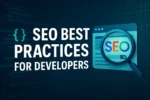Website Optimization: How to Make Your Site Faster, Smarter, and More Effective

In a world where people expect websites to load in seconds and information to be just a click away, your site doesn’t get a second chance to make a good first impression. Whether you’re running a personal blog, a business site, or an online store, one thing is non-negotiable: website optimization.
But what does “website optimization” really mean? It’s not just about speed—though that’s a big part of it. It’s about creating a seamless, fast, and user-friendly experience that works for both people and search engines.
Let’s break it down and explore how you can turn your website into a high-performing, results-driven machine—without needing to be a tech genius.
Why Website Optimization Matters (More Than You Think)
Think of your website as your digital storefront. If it’s slow to load, hard to navigate, or not mobile-friendly, visitors won’t stick around. Here’s what’s at stake:
- User experience (UX): A smooth, fast site keeps people engaged.
- Search engine rankings (SEO): Google loves optimized sites.
- Conversions: Better performance = more signups, sales, or inquiries.
- Mobile performance: Over 50% of traffic comes from mobile—ignore it and lose visitors.
In short, website optimization isn’t optional—it’s essential.
Speed Is Everything: Optimize Loading Time
Nobody likes a slow website. Research shows that even a one-second delay in page load time can reduce conversions by up to 7%.
Here’s how to speed things up:
- Compress images without sacrificing quality (use tools like TinyPNG or Squoosh).
- Use modern image formats like WebP.
- Minimize CSS, JavaScript, and HTML files.
- Enable browser caching.
- Consider a content delivery network (CDN) like Cloudflare.
Pro tip: Use tools like Google PageSpeed Insights or GTmetrix to see how your site performs and what to fix.
Make It Mobile-Friendly
Mobile-first is no longer a trend—it’s the standard. Your website should look and function flawlessly on phones and tablets.
Quick wins:
- Use responsive design (most modern themes or builders support this).
- Make buttons and links big enough to tap.
- Avoid pop-ups that are hard to close on small screens.
- Test your site with Google’s Mobile-Friendly Test.
Improve Your On-Page SEO
Search engine optimization is a huge part of website optimization. You want your site to show up when people search for topics you cover or services you offer.
Here’s what to focus on:
- Use clear, keyword-rich titles and headings.
- Write compelling meta descriptions.
- Optimize image alt text.
- Keep URLs short and readable.
- Internally link between pages to guide users and boost SEO.
Don’t just write for algorithms—write for people first, then optimize.
Streamline Your Navigation
If visitors can’t find what they’re looking for in a few clicks, they’ll leave. A well-organized menu and intuitive site structure help users explore without confusion.
Tips:
- Keep your main menu simple and clear.
- Use breadcrumbs for better orientation.
- Create a sitemap to help both users and search engines.
Fix Broken Links & Clean Up Errors
Broken links, 404 pages, or outdated content can kill trust and hurt SEO. Run regular audits to fix or remove bad links and update stale pages.
Tools like Screaming Frog, Ahrefs, or even a basic plugin like Broken Link Checker (for WordPress) can help keep your site error-free.
Enhance Core Web Vitals
Google uses Core Web Vitals to assess user experience based on three key metrics:
- Largest Contentful Paint (LCP): Measures loading performance.
- First Input Delay (FID): Measures interactivity.
- Cumulative Layout Shift (CLS): Measures visual stability.
Improving these factors not only boosts SEO but creates a smoother browsing experience.
Secure Your Website
A secure website builds trust with visitors and is now a ranking factor for Google.
Make sure you:
- Use HTTPS (SSL certificate).
- Keep plugins, themes, and platforms updated.
- Use strong passwords and reliable hosting.
- Add basic firewall or security plugins.
Track Performance & Keep Testing
Website optimization is not a one-time task—it’s ongoing. Use analytics tools to understand how people interact with your site and where you can improve.
Essential tools:
- Google Analytics – for traffic and behavior insights.
- Google Search Console – for indexing and SEO performance.
- Hotjar or Microsoft Clarity – for heatmaps and user session recordings.
Always be testing—and improving.
Final Thoughts
Website optimization is the quiet powerhouse behind successful websites. When done right, it improves speed, enhances user experience, boosts your Google rankings, and increases conversions—all while making your site more enjoyable to use.
You don’t need to be a developer or spend thousands to get started. Focus on the basics, stay consistent, and keep learning. Because in the digital world, an optimized website isn’t just nice to have—it’s your strongest competitive edge.






